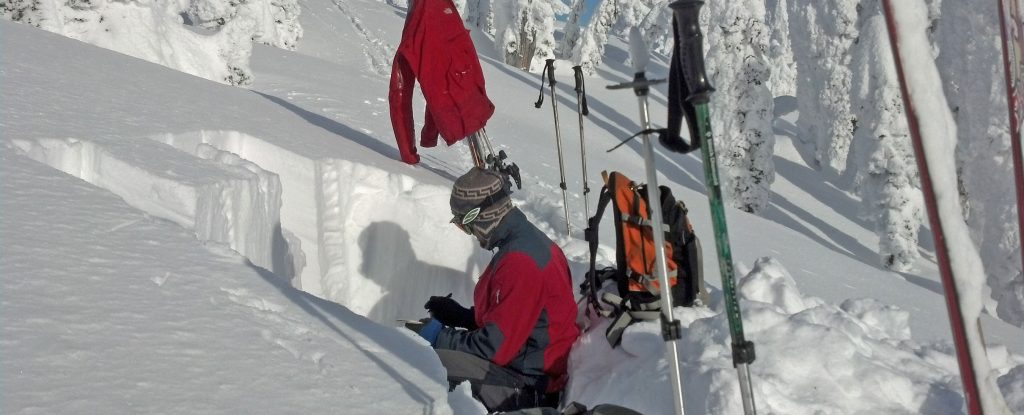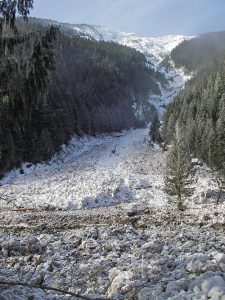Avalanche of Change
From the Winter 2017 Issue
Eric Morgan

The new face of snow in North Idaho
Kevin Davis has spent 20-plus years working and playing in the wintry backcountry of Sandpoint’s bookend mountain ranges.
On the job for the U.S. Forest Service and the Idaho Panhandle Avalanche Center, Davis monitors weather fronts and SNOTEL data across a wide swath of the Northern Rockies, then tidily chisels backcountry snow pits to take a look inside.
After hours and on days off, he carves deep turns on some of those same untamed slopes, putting his weekly avalanche advisories to real-life tests in the Cabinet and Selkirk mountains.
Who better, then, to ask whether North Idaho is feeling the effects of climate change?
Davis’ answer is an unequivocal, but thoughtful, “Yes.”
“In the 20 years that I’ve been out in the snow digging pits and keeping track of things, we are seeing a direct correlation between changes in the climate and the stability of our snowpack,” he said. “The climate is changing, and so are avalanches.”
Even if the statistics didn’t bear him out, and they do, Davis has more than enough eyewitness testimony to show what is happening locally as Earth warms and the climate responds accordingly.
“In the mid-1990s, we would get 16, 18 feet of snow in these big, deep storms,” he said. “And it would snow consistently from November right through to April – solid winter. Maybe there was a break with cold, clear weather in February, but it stayed cold. That just seemed to be how winter was. You could count on it.
“Well, now, sometimes winter doesn’t start until mid-December, and the weather changes from cold and clear to warm and rainy more times throughout the winter. We get these flip-flops where it goes from really cold and not much snow, to warm and rainy, to snowing, to … ”
And although it seems counter-intuitive, Davis now finds his avalanche-forecasting work more difficult than ever.
“The tricky thing is people might think that less snow equals less avalanche danger, but actually the opposite is true,” he said. “With more storms, you get more layers in the snowpack and that can make it more prone to sliding. Even though it is not as much snow, there may be more opportunities in those layers to potentially slide.”
Consider this scenario
Rain comes early, leaving behind layers of icy crust at the base of the snowpack. The ice is weak, but can last for a month or two buried beneath the snow that falls as the cold deepens.
“And so you have these problematic, unstable layers from the very start of the winter,” Davis said.
Then come the rapid weather events, “extreme changes in the weather,” he said.
So Davis finds himself talking not about climate change to the backcountry travelers he serves, but about the weather right now and how it is affecting the snow stability right here.
The urgency is in his voice before the season’s first snowfall.
“I think people should be aware of climate change and its long-term effects on our seasonal snowpack,” Davis said. “Whether we have snow or not is probably my biggest concern.
“But for staying safe in the backcountry, don’t be thinking about climate change. Narrow your thought processes to right here and now. Is this slope capable of producing an avalanche? If I put myself on it, am I going to trigger an avalanche and what’s going to happen? Always think about the conditions and the consequences. And if you don’t know whether a slope is safe, then change your plan or get the information you need to make it safe.”
COMMON VALUES
Sandpoint is a relative newcomer to the debate over how, or if, to push back against global warming. The movement is small and by its own leader’s accounting “not that effective yet,” but Gary Payton remains passionate and resolute in his involvement.
“It’s fair to say that, increasingly for 350Sandpoint, we are involved in the role of education and advocacy,” Payton said “We regularly face an audience – whether it’s a neighbor or a county commissioner or a congressman – who expresses outright skepticism of the science.”
But for Payton and 350Sandpoint’s Jim Akers, there simply is no doubt. “Climate change shouldn’t even be controversial,” Akers said. “It’s the unquestionable reality.”
2015 was the Earth’s hottest year in recorded history. 2016 pushed the bar even higher. Glaciers are receding worldwide; rising sea levels have already claimed some low-lying communities; record-setting storms have left states, even nations, in shambles.
350Sandpoint formed about a year ago to advocate locally for measures that could slow the planet’s warming – and against those which threaten to actually increase the rate of change.
Its members have protested the coal trains that pass through town and joined hundreds of Indian nations in criticizing the proposed Dakota Access pipeline. Payton attended the 2015 Climate Change Conference in Paris and brought home its call to action.
“But we have not turned specifically to the issue of trying to engage our local leaders – political, business, real estate, ski industry – in preparing and adapting for the impacts of climate change,” he said. “That is a level of organization and maturity that we haven’t reached yet.”
In fact, this past summer Payton began reassessing the way he talks with others about climate change.
“I am looking for the common ground within our value systems,” he said. “I have to find a way to sit down and have a conversation with a county commissioner who is a climate-change denier. We can’t just communicate with the choir. We have to communicate with the whole congregation.”
And so Payton now starts the conversation by asking folks if anything has changed about winter over their lifetimes. And they start talking about how much it used to snow in December, and how deep the drifts were by mid-winter, and how the snow has started melting noticeably earlier each spring.
“And when people really start thinking about it, they say things have changed,” Payton said. “They may not be willing to connect the dots to increased CO2 and methane, but they do want to talk about the things that we hold dear, the lifestyles that we have, the activities that draw us together, and our responsibility to the future and our children and grandchildren. When the language gets to our core values, and away from science, there is a potential bridge created to find ways to talk about shared interests and solutions.”
He’s not giving up on 350Sandpoint or more traditional ways of environmental activism but wants to involve Sandpoint business and government leaders in a new kind of community conversation.
“If the (Greater Sandpoint) Chamber of Commerce, if the business leaders, if the senior leadership at Schweitzer were of a similar mind that the climate is changing and that we need to adapt within our own community, then I think we could bring about real change,” he said. “But we’re not there yet.”
CHRISTMAS SNOW
Tom Chasse has been Schweitzer Mountain’s CEO and president since moving to North Idaho 11 years ago. He’s since led a significant transition at Sandpoint’s backyard ski resort.
He doesn’t think about or speculate on climate change, Chasse said, because his focus is on the short-term – the 30-day outlook, tonight’s forecast of blizzard conditions, tomorrow’s bluebird skies.
“My personal opinion is we’ll just take it as it comes,” he said. “There are differing opinions about global warming, but at the end of the day, we’re just going to adapt to differing conditions.”
Under Chasse’s leadership, Schweitzer has solidified its season at a dependable 130 days by installing snowmaking equipment that can provide coverage from mid-mountain down.
The strategy is based on skier behavior. “We have one very dependable route that is open no later than Thanksgiving, and that fills our lodging for Christmas. People wait for us to open to book their holidays. So for us, the investment in snowmaking has held us in at roughly 130 days – and filled the lodges for the holidays.”
When North Idaho’s mix of maritime and Arctic weather systems delivers surprisingly little snow, as in the “catastrophic” season of 2014, Chasse keeps the ski guns running well into the winter.
In 2014, snowmaking kept Schweitzer open for 121 days when it could have been 40 days less. “We were making snow early and mid-season,” he said. “Without it, we would have had a problem.”
But when nature delivers a bounteous snowpack, as the early forecasts suggest for 2016-17, then Schweitzer reaps not only a great season, but a bump in season pass sales for the next winter.
“I really don’t look out much more than three months, because you can’t really change anything anyway,” Chasse said. “It’s more of a marketing challenge than a weather issue.”
Schweitzer has made changes in the name of energy efficiency and all-season amenities, which – even if unintentional – lower the resort’s consumption of fossil fuels and prepare it for a potentially warmer future.
The new snowmaking equipment is 100 percent gravity fed, with tanks at the top of the mountain filled by the previous winter’s snowstorms providing the power and water needed to jump-start the next winter’s base-pack.
“So the water we need for snowmaking comes from nature, and we’ve seen no increase in our power usage,” Chasse said.
The newest lodge is built summit top, and marketed to grow off-season business in a non-traditional way. “Our wedding business has grown, our corporate business has grown. If we can generate interest in our assets in the off-season, that’s all on the plus side. We’ve got new summer dining in the lodge, evening dining, receptions, events like the festival over Labor Day that expose 10,000 people to Schweitzer in a weekend.
“Other resorts are investing in zip lines and water slides and alpine coasters – and I’ve taken a look at those venues. But for us, our strong summer season is eight weeks, and it’s difficult to make those kinds of attractions pencil out in eight weeks. So we haven’t made the big investment in infrastructure, and it’s working.”
In town, Chasse and his team are active on business and civic boards. They’ve teamed up with the city and businesses to expand Sandpoint’s mountain biking network to soon extend from the top of Schweitzer all the way into town. And they’re working with the SPOT public transportation to provide roundtrip service.
But don’t expect to see Chasse entering the political fray – over climate change or any other issue, he said.
“I have my hands full here at the resort.”
Storage Tanks
One of the scores of SNOTEL monitoring stations that Ron Abramovich watches from his Boise desk is at elevation 6,090 feet at Schweitzer Basin. It’s the highest such snow-and-water measuring site in North Idaho, and one of Abramovich’s go-to markers.
His watchfulness, though, is directed not toward skiers, but toward irrigators in the valleys below. “The winter snowpack is critical for our state,” he said. “About 75 percent of Idaho’s annual precipitation falls in the mountains as snow.”
The mountains are the storage tanks for summer’s irrigation needs, and Abramovich’s team at the Natural Resources Conservation Service provides the streamflow forecasts that farmers and ranchers rely upon to parse the dry season’s supply.
Sensors show a long-term, continuing decrease in winter and spring snowpack in the Northern Rockies. He worries about irrigators and them adapting to the new normal – whatever it might be.
“This year, the snowpack came off about three weeks earlier than normal,” he said. “The year before, it melted a full month early. Even on years when we have a healthy peak snowpack, it’s coming off early, and that’s bad news for irrigators.”
Temperature is critical in North Idaho, so the moisture that does fall in winter hits the ground as snow.
“Snow is always better,” said Abramovich. “Rain just flushes straight down into the rivers. We can’t store as much rain in winter.”
A 2015 Western snowfall paper by University of Idaho researchers shows a “major hydrological shift” from snow to rain because of higher wintertime temperatures. In 11 Western states, a 30 percent decrease in areas where it’s cold enough for lasting snow by mid-century is projected.
Among the “significant statewide trends” noted: “Mean annual air temperature has increased, growing seasons have become longer, lilacs have bloomed earlier, and more forest area has burned.”
The University of Washington’s Climate Change Impacts Group projects the same for the Pacific Northwest.
The winter of 2014-15 looked “a lot more like what we’d expect in the mid-21st century,” said John Abatzoglou, a University of Idaho climatologist and coauthor of the paper.
In fact, researchers from the Idaho and Washington climate groups spent much of that winter in the field, documenting the impacts as a kind of picture of the future.
“This year is really interesting because it’s what our global climate models are forecasting for the future,” climatologist Karin Bumbaco told reporters before a May 2015 gathering of scientists in Boise. By 2050, “we would expect winters like this, with a whole lot of rain and not so much snow.”
It’s all new territory, though, and no one knows exactly how the long-term climate trends will play out – how quickly or dramatically wintertime conditions will change. Where will the snowline begin? How much will winter’s margins be squeezed? How many days each year will the snow be skiable?
“Things are still changing,” said Davis, at the Idaho Panhandle Avalanche Center. “In Colorado, they are seeing more wet avalanches, which they never used to see. The classic avalanche is the big powder cloud sweeping down the mountain at 150 mph.
“Well, now, Colorado is seeing these big, wet-slab avalanches that are more like big slushies moving down the mountain. They’re pretty destructive and really heavy, and are more directly attributable to climate change.”
The mountain snowpack in North Idaho and western Montana has a more complicated mix of weather, said Davis, a hydrologist who spends his warmer months studying water for the U.S. Forest Service. “We are in an area that experiences a little bit of both – the cold continental weather and the wet maritime weather,” he said. “That presents more variability in our snowpack, and in our winters. It means we see both wet and dry avalanches, and a mix of winter rains and snows.
“One week, it’s minus 10 degrees and you’ve got 2 feet of cold, fluffy snow, and the next week it’s 40 degrees and snowing and raining at the same time.”
 Lake Pend Oreille further complicates the picture in the mountains around Sandpoint, Davis said. “The Cabinet Mountains snowpack can be a little deeper because of the lake effect. So sometimes you get a little bit more snow from storms in the Cabinets, but also then that can translate to rain. So it could be raining in the Cabinets, but snowing up at Schweitzer.”
Lake Pend Oreille further complicates the picture in the mountains around Sandpoint, Davis said. “The Cabinet Mountains snowpack can be a little deeper because of the lake effect. So sometimes you get a little bit more snow from storms in the Cabinets, but also then that can translate to rain. So it could be raining in the Cabinets, but snowing up at Schweitzer.”
Davis’ concern is that climate change will bring increasingly less snow and more rain to the mountains where he works and plays.
“There’s a higher probability that winter storms will come in as rain,” he said, “so maybe the lower elevations in our mountains won’t be covered very well. We saw that a few years ago, where it was difficult to get into the mountains because of the lack of snow.”
And while ski resorts can, and do, control the vegetation on their slopes, many backcountry forests are becoming choked with trees, Davis said. “And when we don’t get a deep snowpack, all those trees are poking up through the snow. I’m seeing a lot of terrain that I used to use choked with trees.”
Davis calls himself “hopeful” but cautious. “I vote on these types of issues, for people who are going to advocate toward wise planning and zoning and energy use. I’m hopeful, but I’m not so sure it is going to be a quick turnaround. As long as gas remains at $2.50, it’s not a big incentive for people to get away from fossil fuels. And with coal trains coming all the way from Montana and Wyoming and being shipped to China … ”
“Our existence as we know it in the West is driven by the winter snowpack,” Davis said. “And that existence is going to change.”




Leave a Reply